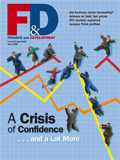 About F&D Subscribe Back Issues Write Us Copyright Information Free Email Notification Receive emails when we post new
items of interest to you. |
Picture This Bridging the Technology Divide Technological progress—improvements in the ways that goods and services are produced, marketed, and brought to market—is at the very heart of human advancement and development. It has helped reduce the share of people living in absolute poverty in developing countries from 29 percent in 1990 to 18 percent in 2004.
Technological progress in developing countries (that is, low-income, lower-middle-income, and upper-middleincome countries) outstripped progress in high-income countries between the early 1990s and 2000s. Of course, the initial level of technology in lower-income countries was much lower to begin with.
As a result, the technology gap between rich and poor countries has narrowed, although it remains wide. Low-income countries employ only one-fourth the technology used in high-income countries.
The very strong technological progress developing countries have enjoyed has come mainly from adopting and absorbing existing technologies. Compared with the size of their economies, they perform relatively little new-to-theworld innovation.
The diffusion of technology across developing countries has been facilitated by their increased exposure to foreign technologies. Over the past 15 years, foreign direct investment levels and imports of high-technology and capital goods have doubled as a percent of GDP—in part because of contacts with well-educated migrant populations living abroad.
Partly as a result of this increased exposure, newer technology— such as cell phones, computers, and the Internet—now spreads much more quickly. In the early 1900s, new technology took more than 50 years to reach most countries; today it takes about 16 years. But technology tends to spread slowly within countries because many developing countries lack the technical skills necessary to master new, or even older, technologies.
Slow diffusion within countries means that, although individual cities may be technology leaders, the use of technology in a country as a whole may be low. For instance, while more than 1 in 2 urban Indian families has cell phone access, only 1 in 10 in the rural sector does.
Although better macroeconomic and educational policies, as well as the spread of older enabling technologies—such as electrical networks, road infrastructure, telephone land lines, and sanitation networks—have advanced the spread of technology in developing countries, progress has been slow and the capacity to absorb new ideas and techniques remains weak. Closing the gap
|